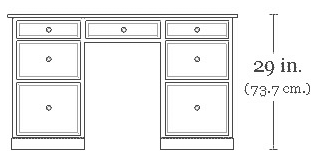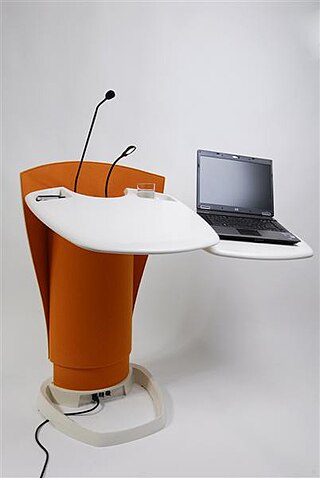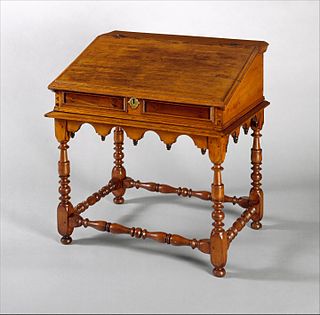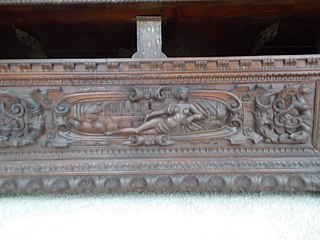
Furniture refers to objects intended to support various human activities such as seating, eating (tables), storing items, working, and sleeping. Furniture is also used to hold objects at a convenient height for work, or to store things. Furniture can be a product of design and can be considered a form of decorative art. In addition to furniture's functional role, it can serve a symbolic or religious purpose. It can be made from a vast multitude of materials, including metal, plastic, and wood. Furniture can be made using a variety of woodworking joints which often reflects the local culture.

An armoire desk is a writing-table built within a large cabinet, usually 1.5–2.0 metres high. The cabinet is closed by two to four full-height doors, to keep out dust or to give a tidy appearance to a room by hiding the cluttered working surface of the desk. This form of desk is usually placed against a wall, like its antique uncle, the secretary desk.

A desk or bureau is a piece of furniture with a flat table-style work surface used in a school, office, home or the like for academic, professional or domestic activities such as reading, writing, or using equipment such as a computer. Desks often have one or more drawers, compartments, or pigeonholes to store items such as office supplies and papers. Desks are usually made of wood or metal, although materials such as glass are sometimes seen.

A pedestal desk or a tanker desk is usually a large, flat, free-standing desk made of a simple rectangular working surface resting on two pedestals or small cabinets of stacked drawers of one or two sizes, with plinths around the bases. Often, there is also a central large drawer above the legs and knees of the user. Sometimes, especially in the 19th century and modern examples, a "modesty panel" is placed in front, between the pedestals, to hide the legs and knees of the user from anyone else sitting or standing in front. This variation is sometimes called a "panel desk". The smaller and older pedestal desks with such a panel are sometimes called kneehole desks, they were intended for small spaces like boudoirs and were usually placed against a wall. The kneehole desks are also known as bureau tables.

A secretary desk or escritoire is made of a base of wide drawers topped by a desk with a hinged desktop surface, which is in turn topped by a bookcase usually closed with a pair of doors, often made of glass. The whole is usually a single, tall and heavy piece of furniture.
The portable desk had many forms and is an ancestor of the portable computer, the modern laptop an atavistic grandchild of the 19th-century lap desk.

There are two kinds of trestle desk: as with trestle tables, some have trestles joined by one or more stretchers, and some have free-standing trestles. They can be dismantled, with the desk top removed from the trestles, for storage or transport.

The lectern desk exists in two distinct forms, antique and modern.

A Bible box is a small container that is used to store a bible. About the size of a bible, this box could be used to transport in safety what was a very costly book. Many varieties had a slanted or angled top with a lower lip, meant to hold the Bible for reading when the box was placed on a table. In a sense it then served as a portable lectern. Over the years the typical Bible box was also used or specifically built to contain writing implements such as a quill, ink pot, blotting paper and writing paper. The level or slanted surface of the box then served as a desktop for writing as well as reading.

A Davenport desk, is a small desk with an inclined lifting desktop attached with hinges to the back of the body. Lifting the desktop accesses a large compartment with storage space for paper and other writing implements, and smaller spaces in the forms of small drawers and pigeonholes. The Davenport has drawers on one of its sides, which are sometimes concealed by a panel. This stack of side drawers holds up the back of the desk and most of its weight.

In cabinetry, the bargueño is a form of portable desk, made up of two chests, the bottom one usually having drawers and the top one having a hinged desk surface which also serves as a side-mounted lid. It is basically a chest or box with one of the side panels, rather than the top panel, serving as a fold-out writing surface. The interior of the desk is equipped with small drawers, pigeonholes, etc., for storing papers and supplies. The bargueño has also been used for sewing or as a jewel chest.
A campaign desk is an antique desk of normal size which was used by officers and their staffs in rear areas during a military campaign.
The lap desk is a desk set in the lap. In the European tradition, it can be considered a modern form of the portable desk.

The desk on a frame is usually an antique form made up of two pieces of furniture. The first piece is a fairly large and closable portable desk with a slanted hinged top giving access to the writing surface and utility nooks and small drawers. The second piece is a stand made for it in the same style and material. It is also sometimes a single piece of furniture which looks as if it were made up of the two previous pieces but is in fact solid and nondetachable. This form was popular in Colonial America and was often done in the Queen Anne style.

A chest is a form of furniture typically of a rectangular structure with four walls and a removable or hinged lid, used for storage, usually of personal items. The interior space may be subdivided.
Campaign furniture is a type of furniture which is made for travel. Historically, much of it was made for military campaigns.

A hope chest, also called dowry chest, cedar chest, trousseau chest, or glory box, is a piece of furniture once commonly used by unmarried young women to collect items, such as clothing and household linen, in anticipation of married life.
Ross and Co. of Dublin was an Irish company that manufactured campaign furniture, primarily for military officers and officials going overseas. The company opened around 1820 and closed around 1909.

What later came to be known as the William and Mary style is a furniture design common from 1700 to 1725 in the Netherlands, Kingdom of England, Kingdom of Scotland and Kingdom of Ireland, and later in England's American colonies. It was a transitional style between Mannerist furniture and Queen Anne furniture. Sturdy, emphasizing both straight lines and curves, and featuring elaborate carving and woodturning, the style was one of the first to imitate Asian design elements such as japanning.















